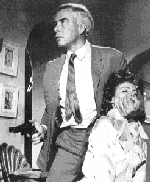
"THE BIG SLEEP" by Howard Hawks (1946)
FROM CLASSICS TO MODERN NOIR
|
The origins of this kind of film are found at the end of
the 30's and
during the early 40's.
Its high popularity lasted all along the 40's and 50's.
This era produced some of the classics of the genre, and
most of the best
of them can be still seen today without any loss of
interest.
|

"THE BIG SLEEP" by Howard Hawks (1946)
|
Suddenly the screen displayed more realistic stories of
crime and detectives,
far from the gangster stories that were distributed
earlier. Flourishing in the B type productions in Hollywood, some of the best film makers of the time were involved at their cinematographic debuts with hard-boiled mystery films. Confirmed directors, some of whom were amongst the best Hollywood ever harbored, put their unmistakable talent in these tough and often tragic stories of corruption in society. As a consequence, this new breed of film, mostly of a quality well above Hollywood's average, rapidly became very popular, and they would have an indelible influence on American film history, leaving their mark on the following developments of cinema of quality. Foreign film makers were also deeply influenced, and besides some obvious assimilation by foreign directors, film Noir is one of the main roots of the French Nouvelle Vague (New Wave) from the end of the fifties, mainly for its cinema esthetics and technique. Some French critics, after WW2, coined the word Noir for these films that had all common traits in their forms, in their ethics and pessimistic views of the world. Their quasi-existentialist treatment of the plots was also found in cinema genres other than pure mysteries or crime stories, and Noir could as well qualify for some Westerns, war movies, Science Fiction, and dramas. But crime, violence and individual rebellion against corrupt authorities were always the fertile common backgrounds for these pessimistic tales. From the beginning, Hard-Boiled literature was the backbone of the emerging cinema genre, either by delivering top novels to be adapted for the screen or by providing talented mystery writers as scriptwriters for these films. The film genre succeeded in creating its visual myths and symbols, equivalent to the literary creations of the Hard-Boiled novels of the time.
If we establish a parallel for the timing and development of Noir in literature and cinema, we have to conclude that cinema was the vehicle that allowed the HB/Noir genre to survive until the present day. As this type of literature was neglected and voluntarily underpublished by the major publishing houses during the seventies in America, it threatened to disappear. The low esteem given to it there by traditional literary critics and the American view of it as "just entertainment" were two more factors accelerating the decay. However, films continued to carry the genre in modern plots and characters, but with the same tough and pessimistic view of society found in the older productions. And good detective/crime films always found an audience, which kept Hollywood interested. On the other hand, the appearance of video cassettes, allied with TV broadcasts of old films retrospectives, ensured the perpetuation of the myths and intrinsic qualities of the HB/Noir genre to a younger generation of viewers. It is a fact that in today's USA, old and not-so-recent films are more easily available than most of the best HB novels of the past, maybe even of last year! It seems, however, that the situation has improved recently and HB and Noir novels have received some more attention from publishers. We can obseve that during the last decade there was a slight revival of this literature, bringing new authors, contemporary views, and occasionally better literary treatment to the HB/Noir novels. The story outside the USA is very different! In countries like France and Italy, dark Noir or HB novels are praised. In France there was an uninterrupted production and mass publishing of these novels by local authors since the fifties, and at the same time a valuation of the best American authors judged for their qualities and not only by their place in the best-sellers lists, which kept them in print in their French tanslations! This explains the blooming of very good Noir films produced in France during the 60's and 70's, having a pool of American novels and local writers of quality still at their disposal, with an incredibly interested reading public. However, for its recent evolution, foreign film Noir had a different fate. In term of production, American films are still present everywhere and far outnumber films from other Western countries. It is even more true since the eighties, due to declining numbers of foreign productions for diverse reasons (one of them being the continuous shrinking number of spectators in theaters, all over Western Europe). This leads to the spread the modern American HB/Noir film styles to foreign countries during the recent years, filling the increasing absence of equivalent foreign productions. It remains a fact that American cinema continues to be an important vehicle for promoting the evolution of the genre. We are even inclined, personally, to think that American cinema shows a better continuity for the genre, today, than the corresponding American popular literature (especially for the more Hard-Boiled oriented stories). But this could change if local and foreign HB/Noir contemporary literature finds a better audience in the USA in the coming years. Whatever the issue will be, the cross-fertilization between the two media, books and films, is and will remain an important factor of evolution for the genre. It is impossible to dissociate them when looking at the present-day achievements of the HB/Noir genre. Film is here to stay as a major vehicle for the survival of the HB/Noir genre. |

RECOMMENDATIONS - 1935 to present days
See our films lists - next page >>>>>>>
|
E.Borgers freeweb@rocketmail.com
Copyright © 1999, E.Borgers for texts and setup. |